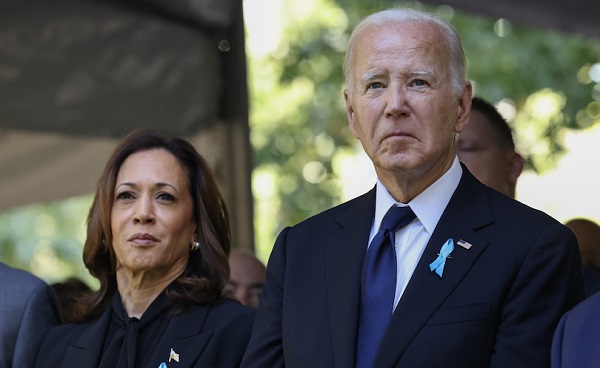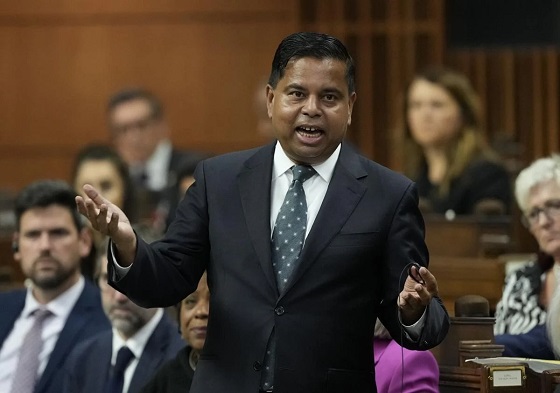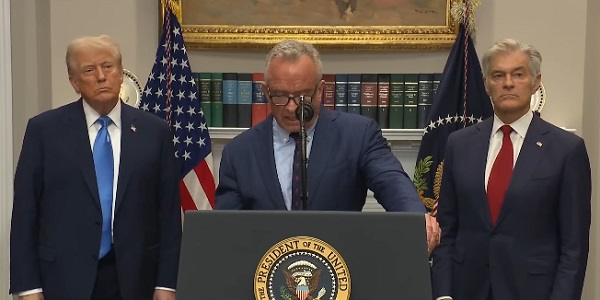Daily Caller
Biden Admin ‘Intentionally Buried’ Inconvenient Study To Justify Major Energy Crackdown, Sources Say


From the Daily Caller News Foundation
By Nick Pope
The Biden administration deliberately buried a final draft version of a study that would have undermined its January 2024 decision to pause approvals for liquefied natural gas (LNG) export projects, according to four Department of Energy (DOE) sources.
Former Energy Secretary Jennifer Granholm and former President Joe Biden announced the LNG freeze in January 2024, stating that it would remain in place until the DOE could conduct a fresh study of the climate and economic impacts of LNG export growth. The Biden DOE finalized a draft of the study in 2023 and subsequently buried it because the initial version’s findings would have contradicted the administration’s rationale for the LNG freeze, according to four sources inside the Trump DOE granted anonymity by the Daily Caller News Foundation to freely discuss a sensitive matter.
“The Energy Department has learned that former Secretary Granholm and the Biden White House intentionally buried a lot of data and released a skewed study to discredit the benefits of American LNG,” one DOE source told the DCNF. “They were prioritizing their own political ambitions over the interests of the American people, and the administration intentionally deceived the American public to advance an agenda that harmed American energy security, the environment and American lives.”
The Biden DOE had essentially completed the final draft version of the LNG impacts study by the end of September 2023, and that version was ready to be presented to top Biden officials shortly thereafter, Trump DOE sources told the DCNF. That particular iteration of the study, DOE sources told the DCNF, found that increasing U.S. LNG exports would actually bring about a reduction in global emissions relative to other scenarios.
That particular finding is at odds with Granholm’s analysis of the final version of the study released to the public in December 2024, in which she argued that any increase in LNG exports will result in higher global greenhouse gas emissions.
At the end of September 2023, a Biden administration official left a comment on the final draft version that instructed others to halt work on it until further notice, despite other language in the document stating that the final version was to be published sometime around the end of September 2023, Trump DOE sources told the DCNF. That version of the study was never released publicly, and the Biden DOE considered it to be a “working document” given that the agency subsequently categorized it as part of an internal deliberative process, according to DOE sources.
Additionally, the Biden DOE appears to have deleted numerous pages that appeared in the September 2023 draft version from what became the final version of the report released to the public at the end of 2024, the Trump DOE sources told the DCNF.
While the September 2023 and December 2024 versions of the paper bear the same name, the final version released to the public did not include a specific type of analysis of LNG exports known as the consideration of market effects, Trump DOE sources told the DCNF. That particular analysis — included in the buried September 2023 version of the study, but not the final product — found that U.S. LNG exports would bring down global emissions by displacing more polluting sources of energy abroad, and its absence from the December 2024 version allowed the Biden DOE to skew the final report’s findings against increasing LNG exports.
The evidence showing that the Biden administration buried the initial, politically inconvenient version of the study and misled the American public in the process will soon be transmitted to Congress and to the public, DOE sources told the DCNF.
Granholm and Biden each made statements after the pause was announced implying that the administration was freezing LNG export approvals to pursue answers that Trump DOE sources say had already been found, and that Biden officials chose to ignore. Specifically, both Biden and Granholm suggested that increased LNG exports would be a net negative for the global climate, with Granholm definitively saying as much after the final study was released to the public in December 2024.
“During this period, we will take a hard look at the impacts of LNG exports on energy costs, America’s energy security, and our environment. This pause on new LNG approvals sees the climate crisis for what it is: the existential threat of our time,” Biden said in a statement the day the pause was announced. “While MAGA Republicans willfully deny the urgency of the climate crisis, condemning the American people to a dangerous future, my Administration will not be complacent. We will not cede to special interests.”
Notably, House Speaker Mike Johnson recalled to The Free Press in January 2025 that Biden “genuinely didn’t know what he had signed” when he asked the president about the decision to freeze LNG approvals in January 2024, with the Republican adding that he left that meeting with the impression that Biden was not actually running the country in practice.
The DOE stated that it would “initiate” a review to determine whether increasing LNG exports is in the public interest in its statement on Jan. 26, 2024, the day the pause was announced.
Granholm claimed that the final version of the study released to the public in December 2024 demonstrates that “in every scenario, increases in LNG exports would lead to increases in global net emissions,” and that “a business-as-usual approach is neither sustainable nor advisable.” When the pause was first announced in January 2024, Granholm said in a statement that the review “will ensure that DOE remains a responsible actor using the most up-to-date economic and environmental analyses.”
Business
Over $2B California Solar Plant Built To Last, Now Closing Over Inefficiency


From the Daily Caller News Foundation
By Hailey Gomez
The partially taxpayer-funded Ivanpah Solar Power Facility in California’s Mojave Desert is set to shut down in 2026 due to inefficiency in generating solar energy, according to the New York Post.
The $2.2 billion plant, which features three 459-foot towers, was greenlit in 2010 and completed in 2014. According to the New York Post the closure stems from the site being “outpaced by solar photovoltaic technology” and proving both inefficient and costly. The shutter of the site comes more than a decade ahead of its original 2039 end date, according to the Associated Press.
Speculation about Ivanpah’s early closure began in January, when Pacific Gas & Electric announced an agreement with the plant’s owners to terminate its contracts.
“Ivanpah Solar was built when developers were investing in many different types of clean energy. The goal was to find efficient and affordable technologies to reduce the need for greenhouse gas-emitting fossil fuels,” PG&E wrote in a January press statement.
“The technology had worked on a smaller scale in Europe. Spain had several concentrating solar projects of up to 20 megawatts. In the 2000s and 2010s, various private companies invested in large-scale concentrating solar power in the United States. But over time, solar photovoltaic technology raced ahead of its rival in affordability,” the press statement continued.
Funds for the massive plant partially came from former President Barack Obama’s Department of Energy, which in 2011 issued $1.6 billion in three federal loan guarantees under former Secretary of Energy Ernest Moniz. At the 2014 opening, Moniz touted federal support for the project, calling it “a shining example” of America’s leadership in solar energy.
“The Ivanpah project is a shining example of how America is becoming a world leader in solar energy,” said Secretary Moniz, as reported by PBS. “As the President made clear in the State of the Union, we must continue to move toward a cleaner energy economy, and this project shows that building a clean energy economy creates jobs, curbs greenhouse gas emissions, and fosters American innovation.”
In recent years, California has faced mounting problems with solar energy and refineries. In August 2024, major rooftop solar company SunPower filed for Chapter 11 bankruptcy in Delaware after struggling with issues like California’s rooftop solar subsidy programs and high interest rates.
Daily Caller
Shale Execs Complain Of ‘Broken’ Prospects In New Survey


From the Daily Caller News Foundation
In his remarks at this week’s U.N. Climate Week conference, President Donald Trump reminded the U.N. general assembly that “we have an expression, ‘drill, baby, drill.’ You know, that’s what we’re doing.”
But according to almost 80% of the dozens of shale oil executives who responded to the third quarter survey of oil and gas companies by the Dallas branch of the Federal Reserve, that’s all about to come to an end thanks in large part to the President’s focus on cutting oil prices as a means of controlling inflation.
“The uncertainty from the administration’s policies has put a damper on all investment in the oilpatch,” one executive said. Another warns that “drilling is going to disappear.”
Dear Readers:
As a nonprofit, we are dependent on the generosity of our readers.
Please consider making a small donation of any amount here.
Thank you!
One upstream company executive was especially angry at the administration, writing that the business “has been gutted by political hostility and economic ignorance. The previous administration vilified the industry, buried it in regulation and cheered the flight of capital under the environmental, social and governance banner…Now the current administration is finishing the job.”
The confidential format of the Dallas Fed’s quarterly surveys encourages the executives to speak bluntly in their responses, and the airing of such grievances is often the result. Most would no doubt temper their language in a meeting with the President or his senior officials, and other respondents did just that, noting that their industry and companies have been buffeted this year by an array of factors, both domestically and internationally.
“There are a variety of issues affecting our business,” one respondent points out. “First, excess in the global oil market is restraining oil prices near term. Second, there is continued uncertainty from OPEC+ unwinding production cuts. Third, trade and tariff changes and the resulting geopolitical tensions.”
He or she isn’t wrong. While shale drillers and producers have no doubt been frustrated by the constantly shifting tariff situation as the White House works out trade deals with dozens of countries, there are other major market factors well beyond any U.S. president’s control. The uncertainty around tariffs has without question increased industry costs, especially as they relate to tubular goods and other steel and aluminum products that are integral to their operations. But at the same time, there can be little doubt that the monthly machinations of the OPEC+ cartel have created a much larger impact on driving down the price of crude oil and thus, driving down company profits.
As for the geopolitical tensions the responder mentions above, Joe Biden’s four years in office were chock-full of such issues, many of which were left behind for Mr. Trump to deal with and resolve. The simple truth is that there has never been a time during its 166-year history that the U.S. oil and gas industry didn’t have to deal with such complications.
The oil business is an infamously cyclical one, as anyone who has been in it for more than a year understands. I spent more than 40 years in the industry and would need to use fingers on more than one hand to total up the number of boom-and-bust cycles that took place during that span.
The fact is that drilling levels in the United States have been on a steady decline since late 2018 in response to prevailing market factors far more than to the policies of the Biden or Trump administrations. As I pointed out shortly after last November’s election, the maturity of every major shale play meant that there would be no revival of “drill, baby, drill” in a second Trump presidency regardless of the administration’s policy direction. It just was never going to be in the cards.
The grievances and frustrations aired by these executives are entirely understandable: It’s a tough business that is impacted for better or worse by public policies. But pointing the finger of blame at Trump is a simplistic reaction to a highly complex set of circumstances.
David Blackmon is an energy writer and consultant based in Texas. He spent 40 years in the oil and gas business, where he specialized in public policy and communications.
-

 Business21 hours ago
Business21 hours agoOver $2B California Solar Plant Built To Last, Now Closing Over Inefficiency
-

 espionage2 days ago
espionage2 days agoCanada Under Siege: Sparking a National Dialogue on Security and Corruption
-

 Business20 hours ago
Business20 hours agoWEF has a plan to overhaul the global financial system by monetizing nature
-

 Business22 hours ago
Business22 hours agoThe Leaked Conversation at the heart of the federal Gun Buyback Boondoggle
-

 Business2 days ago
Business2 days agoGoogle Admits Biden White House Pressured Content Removal, Promises to Restore Banned YouTube Accounts
-

 Opinion21 hours ago
Opinion21 hours agoThe City of Red Deer’s financial mess – KPMG report outlines failure of council to control spending
-

 Business2 days ago
Business2 days agoBC Ferries Deal With China Risks Canada’s Security
-

 armed forces2 days ago
armed forces2 days agoUnderfunded and undermanned, Canada’s Reserves are facing a crisis





